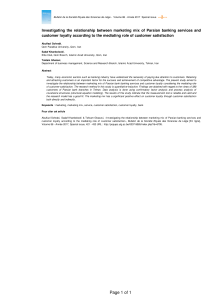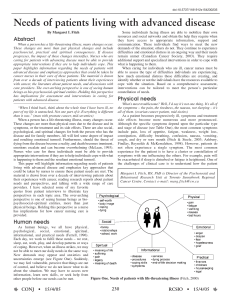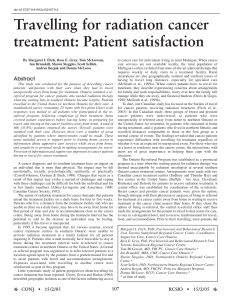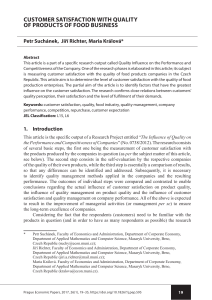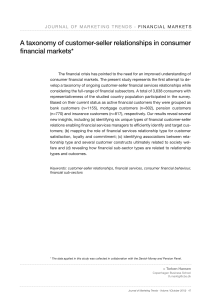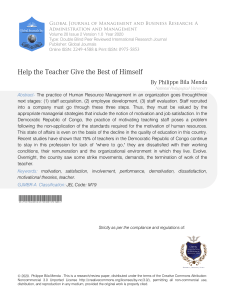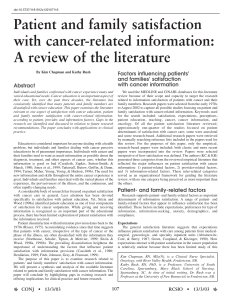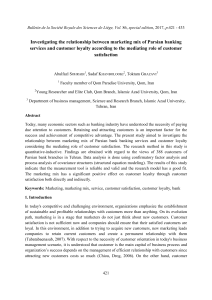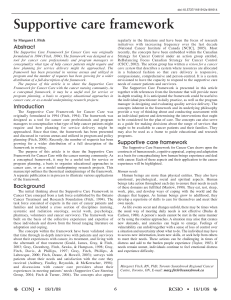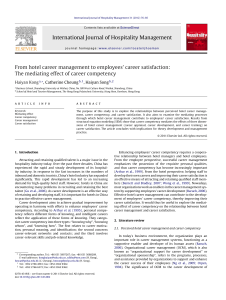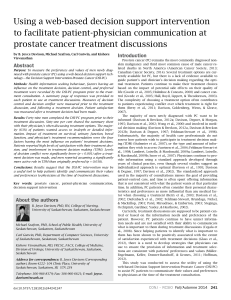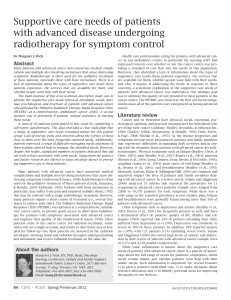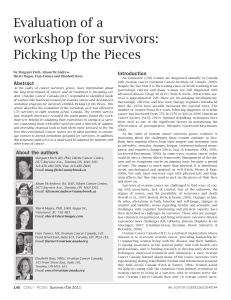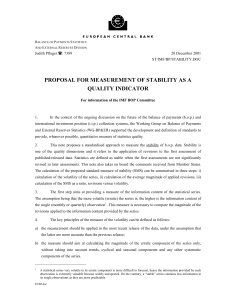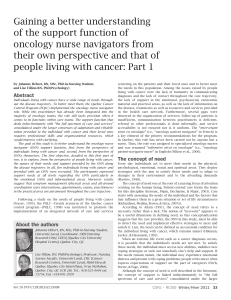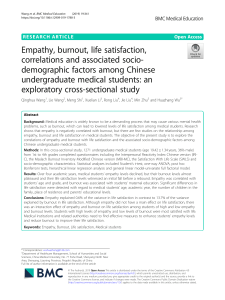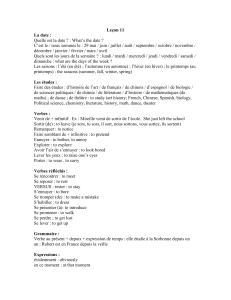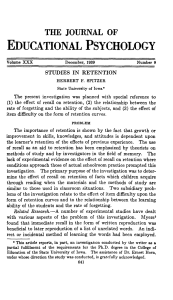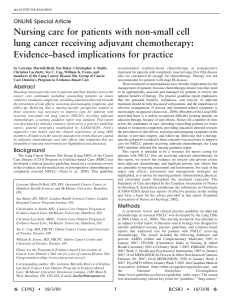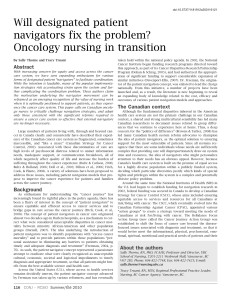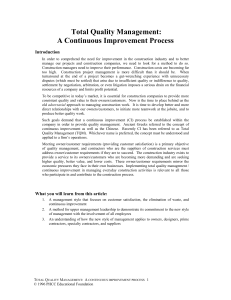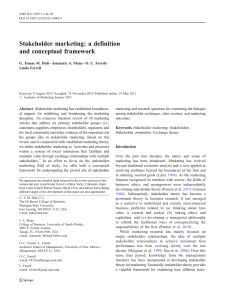by Margaret I. Fitch, Alison McAndrew and Tamara Harth
publicité
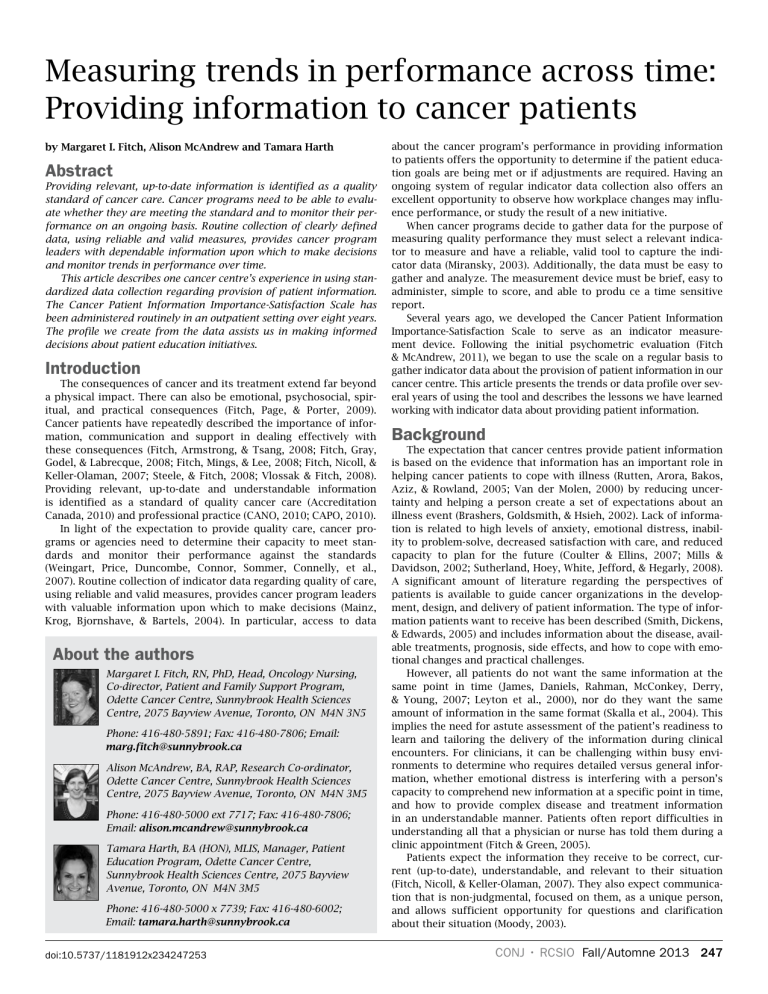
Measuring trends in performance across time: Providing information to cancer patients by Margaret I. Fitch, Alison McAndrew and Tamara Harth Abstract Providing relevant, up-to-date information is identified as a quality standard of cancer care. Cancer programs need to be able to evaluate whether they are meeting the standard and to monitor their performance on an ongoing basis. Routine collection of clearly defined data, using reliable and valid measures, provides cancer program leaders with dependable information upon which to make decisions and monitor trends in performance over time. This article describes one cancer centre’s experience in using standardized data collection regarding provision of patient information. The Cancer Patient Information Importance-Satisfaction Scale has been administered routinely in an outpatient setting over eight years. The profile we create from the data assists us in making informed decisions about patient education initiatives. Introduction The consequences of cancer and its treatment extend far beyond a physical impact. There can also be emotional, psychosocial, spiritual, and practical consequences (Fitch, Page, & Porter, 2009). Cancer patients have repeatedly described the importance of information, communication and support in dealing effectively with these consequences (Fitch, Armstrong, & Tsang, 2008; Fitch, Gray, Godel, & Labrecque, 2008; Fitch, Mings, & Lee, 2008; Fitch, Nicoll, & Keller-Olaman, 2007; Steele, & Fitch, 2008; Vlossak & Fitch, 2008). Providing relevant, up-to-date and understandable information is identified as a standard of quality cancer care (Accreditation Canada, 2010) and professional practice (CANO, 2010; CAPO, 2010). In light of the expectation to provide quality care, cancer programs or agencies need to determine their capacity to meet standards and monitor their performance against the standards (Weingart, Price, Duncombe, Connor, Sommer, Connelly, et al., 2007). Routine collection of indicator data regarding quality of care, using reliable and valid measures, provides cancer program leaders with valuable information upon which to make decisions (Mainz, Krog, Bjornshave, & Bartels, 2004). In particular, access to data About the authors Margaret I. Fitch, RN, PhD, Head, Oncology Nursing, Co-director, Patient and Family Support Program, Odette Cancer Centre, Sunnybrook Health Sciences Centre, 2075 Bayview Avenue, Toronto, ON M4N 3N5 Phone: 416-480-5891; Fax: 416-480-7806; Email: [email protected] Alison McAndrew, BA, RAP, Research Co-ordinator, Odette Cancer Centre, Sunnybrook Health Sciences Centre, 2075 Bayview Avenue, Toronto, ON M4N 3M5 Phone: 416-480-5000 ext 7717; Fax: 416-480-7806; Email: [email protected] Tamara Harth, BA (HON), MLIS, Manager, Patient Education Program, Odette Cancer Centre, Sunnybrook Health Sciences Centre, 2075 Bayview Avenue, Toronto, ON M4N 3M5 Phone: 416-480-5000 x 7739; Fax: 416-480-6002; Email: [email protected] doi:10.5737/1181912x234247253 about the cancer program’s performance in providing information to patients offers the opportunity to determine if the patient education goals are being met or if adjustments are required. Having an ongoing system of regular indicator data collection also offers an excellent opportunity to observe how workplace changes may influence performance, or study the result of a new initiative. When cancer programs decide to gather data for the purpose of measuring quality performance they must select a relevant indicator to measure and have a reliable, valid tool to capture the indicator data (Miransky, 2003). Additionally, the data must be easy to gather and analyze. The measurement device must be brief, easy to administer, simple to score, and able to produ ce a time sensitive report. Several years ago, we developed the Cancer Patient Information Importance-Satisfaction Scale to serve as an indicator measurement device. Following the initial psychometric evaluation (Fitch & McAndrew, 2011), we began to use the scale on a regular basis to gather indicator data about the provision of patient information in our cancer centre. This article presents the trends or data profile over several years of using the tool and describes the lessons we have learned working with indicator data about providing patient information. Background The expectation that cancer centres provide patient information is based on the evidence that information has an important role in helping cancer patients to cope with illness (Rutten, Arora, Bakos, Aziz, & Rowland, 2005; Van der Molen, 2000) by reducing uncertainty and helping a person create a set of expectations about an illness event (Brashers, Goldsmith, & Hsieh, 2002). Lack of information is related to high levels of anxiety, emotional distress, inability to problem-solve, decreased satisfaction with care, and reduced capacity to plan for the future (Coulter & Ellins, 2007; Mills & Davidson, 2002; Sutherland, Hoey, White, Jefford, & Hegarly, 2008). A significant amount of literature regarding the perspectives of patients is available to guide cancer organizations in the development, design, and delivery of patient information. The type of information patients want to receive has been described (Smith, Dickens, & Edwards, 2005) and includes information about the disease, available treatments, prognosis, side effects, and how to cope with emotional changes and practical challenges. However, all patients do not want the same information at the same point in time (James, Daniels, Rahman, McConkey, Derry, & Young, 2007; Leyton et al., 2000), nor do they want the same amount of information in the same format (Skalla et al., 2004). This implies the need for astute assessment of the patient’s readiness to learn and tailoring the delivery of the information during clinical encounters. For clinicians, it can be challenging within busy environments to determine who requires detailed versus general information, whether emotional distress is interfering with a person’s capacity to comprehend new information at a specific point in time, and how to provide complex disease and treatment information in an understandable manner. Patients often report difficulties in understanding all that a physician or nurse has told them during a clinic appointment (Fitch & Green, 2005). Patients expect the information they receive to be correct, current (up-to-date), understandable, and relevant to their situation (Fitch, Nicoll, & Keller-Olaman, 2007). They also expect communication that is non-judgmental, focused on them, as a unique person, and allows sufficient opportunity for questions and clarification about their situation (Moody, 2003). CONJ • RCSIO Fall/Automne 2013 247 Given that providing patient information is a complex process and influenced by many factors, it is important to know if patients are receiving the information they need. Cancer agencies ought to know how well they are meeting quality standards related to patient information. Agencies need to find ways to monitor their performance in this important arena, as circumstances in the care environment are in constant flux and can influence the capacity to provide patient information effectively. Measurement of performance Performance measurement requires gathering data about how well an organization is providing a standard of service or care (Berwick, James, & Coye, 2003). Ideally, clearly defined data are gathered on a routine basis using a reliable and valid measure and are available for regular review, as the basis for decision-making by clinicians and program leaders. Indicator data, collected in numerical form, facilitate presentation of results in graphic format, documentation over time, and comparison across time and jurisdictions. Increases or decreases in the numerical results alert managers and clinicians about potential problems or areas that may need improvement. Such an alert ought to stimulate deeper investigation in an area to determine the root of the issue and understand what can be done to correct the situation. A key step in achieving improvement is regular review of the data by decision makers. Indicator data should be relatively easy to gather on a routine basis, score, and summarize for reporting purposes. Once the psychometric properties of a measurement tool have been established with an appropriately large sample, data can be gathered from smaller samples on a regular basis and allow trends to be monitored relatively easily. Access to trend data provides an excellent opportunity to determine performance over time. Cancer Patient Information Importance-Satisfaction Scale The Cancer Patient Information Importance-Satisfaction Scale was developed as a brief, easily administered indicator tool (Fitch & McAndrew, 2011). The initial psychometric properties were established with a sample of 540 cancer patients attending an ambulatory clinic. Cronbach’s alpha for the Importance Subscale was 0.89 and for the Satisfaction Subscale was 0.92. The topics selected for the 12 items on the tool were drawn from the literature and reflect those topic areas patients most frequently identified as important for them to know (Mills & Sullivan, 1999; Rutten, Arora, Bakos, Aziz, & Rowland, 2005; Skalla, Bakitas, Furstenberg, Ahles, & Henderson, 2004). The tool is formatted on one 11 inch by 8 1/2 inch page with printing on both sides (see Figures 1 and 2). One side of the page has 12 topic items listed and the patient is asked to rate the importance of each topic. The other side of the page has the same 12 topic items, but the person is asked to rate each item in terms of their satisfaction with the information they actually received. Each rating is completed on a 5-point Likert scale. The anchor at one end of the response scales is “not” (0) and at the other end is “very” (4). Additionally the tool captures selected demographic information (i.e., age, gender, type of cancer, time since diagnosis). Purpose The purpose of this article is to highlight the work we have undertaken in performance measurement regarding patient information at our cancer centre. Following the design and testing of an indicator measure, the Cancer Patient Information ImportanceSatisfaction Scale (Fitch & McAndrew, 2011), we began to gather data using this tool and engage in review and dialogue about the results and trends in the data. We believe it could be useful to health care professionals in other cancer centres to learn about our experience. 248 CONJ • RCSIO Fall/Automne 2013 Methods Design, accrual, and procedures The Cancer Patient Information Importance-Satisfaction Scale is administered once a year to a convenience cross-sectional sample of patients attending the cancer centre. Data are gathered from approximately 100 ambulatory cancer patients in the waiting area of our outpatient clinic on each measurement occasion. Patients must be able to read English to participate. Patients are approached, on a convenience basis, as they wait for their clinic appointment by the project assistant. The project assistant determines if the individual is the patient (rather than the family member) and can understand and read English. For those individuals, the assistant then explains what the project is about, what they are being asked to do, and how we are handling confidentiality. If the patient agrees to participate, the individual completes the Cancer Information Importance-Satisfaction Scale while they wait for their appointment. They are given a paper copy of the tool on a hard clip board and a pencil. The tool takes between three and six minutes to complete. The completion of the tool and returning it to the project assistant is deemed evidence of their consent for participation. Neither the patient name nor hospital file number is written on the tool. This approach was approved by the Research Ethics Committee of the hospital. Scoring of the tool and analysis The Cancer Patient Information Importance-Satisfaction Scale (see description above) was designed for use in two ways: as a checklist (each item considered on its own) and as two subscale scores (information importance and information satisfaction). For use as a checklist, each item is scored separately on a scale of 0 to 4. The average item scores for the sample are calculated by adding the individual participant response numbers across the sample and calculating the mean. Calculation of averages allows easier comparison over time and between groups with subsequent administrations of the tool. The two subscale scores (i.e., importance, satisfaction) are calculated by adding item response numbers across all 12 respective items for each participant. The range of possible total response scores for each subscale is 0 to 48. Subsequently, group mean total subscale scores can be calculated. We calculate mean group total subscale scores for the entire sample and for disease-specific groups (gyne, breast, etc.). In addition to the descriptive reporting of results (i.e., total scores and mean scores), we also calculate correlations between the importance and satisfaction scores for each item. Ideally it would be desirable to observe high correlations between these two dimensions. High correlations reflect the idea that patients are satisfied with the information they received in the topic areas they rated as important. Results Results will be presented for seven years and will illustrate the various ways this type of data can be analyzed and made available for review and decision-making. Demographic characteristics Selected demographic characteristics of the samples are presented in Table 1. Given the nature of convenience samples, some variation is expected from sample to sample. The average age in samples ranges between 60 and 65 years, the proportion of females ranges between 49 and 63, and the average time since diagnosis ranges from 1.6 to 3.1 years. Trends in total scale scores The trends in the total subscale scores for importance and satisfaction over the seven years are presented in graphic format in Figure 3. The data from the 2003 sample of 540 served continued on page 250… doi:10.5737/1181912x234247253 Figure 1 : New Information and Satisfaction Measurement Tool Patient Information/Satisfaction Questionnaire Here at the Odette Cancer Centre (OCC), we are interested in improving our patient education resources and understanding where improvements could be made. This study is aimed at identifying the information that you have received at OCC, as well as your satisfaction with that information. This questionnaire is handed out to all willing individuals who are being cared for at OCC. All results will be kept strictly confidential. Completing the survey and returning it gives us permission to use your data for the purposes stated above. Age: ____________ Sex: ____________ Type of Cancer:______________________________________________________ Year of Diagnosis: ____________ Not important Medical condition 0 1 2 3 Very Important 4 Possible side effects of cancer 0 1 2 3 4 Treatment choices available 0 1 2 3 4 Possible side effects of treatment 0 1 2 3 4 Possible emotional reactions 0 1 2 3 4 What to do to relieve physical discomfort 0 1 2 3 4 Diet and nutrition 0 1 2 3 4 Supplies and equipment you might need at home 0 1 2 3 4 Counselling services available 0 1 2 3 4 How to speak with another individual who has cancer 0 1 2 3 4 Alternative therapies for cancer 0 1 2 3 4 Self-help groups 0 1 2 3 4 Please turn over â Figure 2 : New Information and Satisfaction Measurement Tool HOW SATISFIED ARE YOU? By circling one number for each line, please indicate how satisfied you are with the information you have received for each of the following topics: Not Satisfied Very Satisfied Medical condition 0 1 2 3 4 Possible side effects of cancer 0 1 2 3 4 Treatment choices available 0 1 2 3 4 Possible side effects of treatment 0 1 2 3 4 Possible emotional reactions 0 1 2 3 4 What to do to relieve physical discomfort 0 1 2 3 4 Diet and nutrition 0 1 2 3 4 Supplies and equipment you might need at home 0 1 2 3 4 Counselling services available 0 1 2 3 4 How to speak with another individual who has cancer 0 1 2 3 4 Alternative therapies for cancer 0 1 2 3 4 Self-help groups 0 1 2 3 4 Anything else about information you would like to tell us about? ________________________________________________________________________________________________ If you have any questions or concerns about the questionnaire, please ask the research assistant who handed you this questionnaire. Thank you for taking the time to complete this questionnaire. Please return the completed questionnaire to the research assistant. doi:10.5737/1181912x234247253 CONJ • RCSIO Fall/Automne 2013 249 …continued from page 248 as a benchmark. In subsequent years, mean scores fell within +/1 standard deviation of those original scores. Overall the mean importance score in 2009 was 42.1 (+/- 6.9), the highest of all observations, while 2005 registered the highest satisfaction mean score (35.7, +/- 8.4). In 2010, the means fell to 38.8(+/- 8.0) and 30.4 (+/11.4) respectively. The group means for the importance scores are consistently higher than the satisfaction scores. The Pearson Product-Moment Correlation coefficients for the total scores at each time of measurement were rather varied over the years (see Figure 3). In the baseline sample the correlation was statistically significant (r=0.33, p<0.01), as it was in 2005 (r=0.26, p<0.01), 2006 (r=0.46, p<0.01) and 2010 (r=0.47, p<0.01). Assessment of total subscale scores over time for selected disease sites is presented in Table 2. Consistently over time and across all disease site groups, the mean importance scores are higher than the mean satisfaction scores. The largest differences over time between the importance and satisfaction means are within the gynecologic disease site, whereas the smallest differences are in the genitourinary group. Trends in item scores The importance and satisfaction scores for each of the topic items in one of the disease site groups (breast) are presented in Table 3. In general, the topics related to disease, treatments, and side effect management (i.e., physical discomfort, appetite) are consistently rated of higher importance than the items concerning more emotional and practical matters. Satisfaction with the information received across all topic areas is rated as lower than importance. These trends are consistent over time. The correlations between the ratings of importance and satisfaction for each topic item are presented in Table 4. There are statistically significant correlations observed for some items, but the pattern is not consistent over time. The correlations reported as significant reflect low to moderate strengths in the relationship between importance and satisfaction (highest observed correlation coefficient = 0.499, p=0.01). Discussion Regular monitoring of performance, using standardized tools, can provide indicator data for clinicians and program decision-makers to determine where additional attention is required to achieve improvement in patient care. To be useful, this type of monitoring needs to be feasible or manageable, relatively inexpensive, and provide relevant data. Our use of the Cancer Patient Information ImportanceSatisfaction Scale as an indicator measure has provided the opportunity for us to gather data and produce reports easily. We have also seen how the data can be useful in helping us understand where our performance in providing patient information could be enhanced. Table 1: Selected demographics of samples Demographic characteristic Age in years Mean Time since diagnosis (in years) Disease site (proportion of participants in sample) 2010 N = 99 60.6 59.7 60.8 61.2 62.1 60.0 64.8 14.5 14.4 13.8 13.2 12.4 12.6 13.8 Male 46.3% 41.5% 50.7% 46.7% 43.0% 37.0% 38.4% Female 53.7% 58.5% 49.3% 53.3% 57.0% 63.0% 61.6% Mean 3.1 2.1 2.2 2.8 1.6 2.6 3.5 Standard deviation 5.4 3.8 3.9 3.4 3.0 4.6 5.8 Breast 18.7% 27.3% 26.7% 23.4% 29.0% 38.9% 30.9% Gyne 10.8% 9.9% 7.6% 11.5% 5.0% 0.0% 4.3% GU 12.2% 17.4% 20.4% 15.7% 28.0% 9.5% 18.1% GI 11.9% 17.4% 20.0% 13.2% 14.0% 7.4% 10.6% Other 46.4% 28.0% 25.3% 36.2% 24.0% 44.2% 36.1% Standard deviation Gender 2003 N = 557 2004 N = 123 2005 N = 227 2006 N = 246 2008 N = 100 2009 N = 100 Figure 3:Importance and satisfaction over time: Subscale total scores Years 2003 2004 2005 2006 2008 2009 2010 Importance Mean Score 38.12 39.27 38.2 38.64 37.56 42.09 38.88 Importance mean Satisfaction Mean Score 34.99 34.64 35.96 34.35 33.69 35.22 30.4 Satisfaction mean Pearson Correlation Coefficient .332** .154 .299** .459** -.56 -.20 .470** Sample Size (N) 557 124 230 247 100 101 101 48 42 36 30 24 18 12 6 0 250 CONJ • RCSIO Fall/Automne 2013 ** P<0.01 doi:10.5737/1181912x234247253 Table 2: Mean total subscale scores over time for importance and satisfaction Disease site group Breast Gynecologic Genitourinary Gastrointestinal Other (all remaining disease sites) 2003 2004 2005 2006 2008 2009 2010 N 103 32 60 55 29 34 27 Importance 38.6 39.0 40.1 39.9 39.1 41.8 40.2 Satisfaction 35.3 38.0 36.0 34.2 34.1 36.6 29.7 60 12 17 26 5 * 5 Importance 40.6 41.8 40.0 39.4 41.8 * 43.3 Satisfaction 32.8 35.8 34.8 35.5 33.6 * 29.0 67 21 46 37 28 7 14 Importance 37.4 37.0 35.4 36.0 34.7 43.4 39.6 Satisfaction 36.4 35.6 35.2 34.5 31.5 26.9 31.5 N N N 62 21 45 31 14 6 10 Importance 40.2 40.1 40.1 39.9 37.4 42.2 36.6 Satisfaction 36.0 32.0 32.0 36.7 35.2 33.7 32.9 N 258 34 57 85 24 33 32 Importance 37.0 39.6 37.3 39.2 38.2 42.2 36.5 Satisfaction 35.1 32.0 35.2 33.9 32.2 36.1 28.1 * No participants in gynecologic disease site group Table 3: Breast cancer disease site group across time: Individual item mean scores by year Items (topics) Medical condition Possible side effects of cancer Treatment choices available Dimension rated Item mean scores by year 2003 2004 2005 2006 2008 2009 2010 Importance 3.8 3.9 3.9 3.6 3.9 4.0 4.0 Satisfaction 3.6 3.8 3.6 3.4 3.6 3.7 3.5 Importance 3.7 3.8 3.9 3.7 3.7 4.0 3.9 Satisfaction 3.4 3.6 3.4 3.3 3.3 3.5 3.3 Importance 3.8 3.9 3.9 3.7 3.9 3.9 3.9 Satisfaction 3.3 3.7 3.4 3.3 3.4 3.5 3.5 Possible side effects of treatment Importance 3.9 3.9 3.8 3.7 3.9 3.9 3.9 Satisfaction 3.5 3.7 3.5 3.2 3.6 3.5 3.4 Importance 3.3 3.2 3.4 3.6 3.2 3.7 3.5 Satisfaction 3.1 3.2 3.1 3.0 2.8 3.2 2.8 What to do to relieve physical discomfort Importance 3.7 3.7 3.7 3.7 3.9 3.9 3.8 Satisfaction 3.3 3.5 3.3 3.2 3.6 3.3 3.2 Diet and nutrition Importance 3.2 3.4 3.4 3.4 3.6 3.6 3.3 Satisfaction 2.8 3.0 2.9 2.9 2.7 3.0 2.6 Supplies and equipment you might use at home Importance 3.0 3.2 3.1 3.3 3.3 3.6 3.5 Satisfaction 2.9 3.2 3.2 2.9 3.1 3.1 2.4 Counselling services available Importance 2.8 2.8 2.8 3.2 2.8 3.3 3.1 Satisfaction 3.1 3.1 3.1 3.0 2.7 3.2 2.6 How to speak to another individual diagnosed with cancer Importance 2.6 2.4 2.7 2.9 2.8 2.9 3.0 Satisfaction 2.6 2.7 2.8 2.8 2.5 2.8 2.8 Alternative therapies for cancer Importance 2.8 3.1 3.2 3.1 2.5 3.2 2.7 Satisfaction 2.3 2.4 2.3 2.6 2.1 2.3 2.2 Importance 2.3 2.2 2.7 2.8 2.1 2.7 2.6 Satisfaction 2.6 2.6 2.9 2.7 2.5 2.5 2.2 Possible emotional reactions Self-help groups doi:10.5737/1181912x234247253 CONJ • RCSIO Fall/Automne 2013 251 Table 4: Pearson product correlation coefficients between importance and satisfaction item scores Item (topic) 2003 N = 557 2004 N = 123 2005 N = 227 2006 N = 246 2008 N = 100 2009 N = 100 2010 N = 99 Medical condition 0.234** 0.015 0.235** 0.479** 0.053 0.013 0.456** Possible side effects of cancer 0.278** 0.041 0.098 0.463** 0.111 0.050 0.281* Treatment choices available 0.302** 0.016 0.091 0.323** -0.080 0.079 0.499** Possible side effects of treatment 0.296** 0.187* 0.249** 0.391** 0.166 0.183 0.201 Possible emotional reactions 0.246** 0.186* 0.257** 0.322** -0.151 0.067 0.442** What to do to relieve physical discomfort 0.265** 0.062 0.179** 0.319** 0.186 0.022 0.253* Diet and nutrition 0.218** 0.054 0.140** 0.299** 0.064 0.067 0.201 Supplies and equipment you might use at home 0.403** 0.246* 0.402** 0.343** 0.358** 0.084 0.252* Counselling services available 0.300** 0.153 0.245** 0.406** -0.114 -0.004 0.342** How to speak with another individual who has cancer 0.314** 0.228* 0.271** 0.387** 0.007 -0.015 0.353** Alternative therapies for cancer 0.122** 0.103 0.297** 0.329** -0.085 -0.071 0.369** Self-help groups 0.286** 0.220* 0.286** 0.389** 0.097 -0.072 0.147 * significant @ P < 0.05 (2 tailed) ** significant @ P < 0.01 (2 tailed) The measurement tool provides two types of data—scale scores regarding importance and satisfaction, as well as individual topic item scores. The former can be used to track performance at an overall program level while the latter can be used to review performance concerning individual topic areas. Results could also be explored by analyzing the data from selected groups (age, gender) to provide insight for tailoring or targeting education programs. For example, we suspect that the observations about satisfaction in the gynecologic group (all women) versus the genitourinary group (primary men with prostate cancer) are influenced to some extent by gender. Previous work showed that women rate the importance and satisfaction regarding information differently than do men (Fitch & McAndrew, 2011). We have been able to gather data on an annual basis with approximately 100 patients. This is adequate for presenting a picture of our performance as a centre, but has raised questions about the frequency of data collection and the sample size for individual disease site groupings. More frequent data collection has been suggested to make it easier to see the potential issues as soon as possible, as well as to see improvements when a new intervention is offered. Increasing the frequency of data collection would also increase the number of patient observations within each disease site. We also realize the need to translate the measurement tool if we are to access the perspectives of our non-English speaking patients. From a cancer program perspective, we believe the key focus ought to be on ensuring the patients who see a specific topic as important are satisfied with the information they receive about it. The correlation data are helpful in looking at this issue. Given the variation observed in these data, a key future consideration needs to be developing strategies to tailor the provision of information for the individual. The challenge remains how to do this in a busy ambulatory setting within the context of a clinical appointment. The overall decline in the 2010 satisfaction results stimulated concerted reflection by those engaged in patient education strategies for the centre. Of note is that there have been significant increases in patient numbers and the complexities of treatment in 252 CONJ • RCSIO Fall/Automne 2013 the cancer centre and staff have indicated an increasing difficulty in managing their workloads. Their capacity to engage in one-onone teaching has been reduced. Additionally, we have been engaged in physical plant renovations at the cancer centre and the Patient Library/Resource Centre has been affected (i.e., closed prior to moving). These environmental changes are likely reflected in the lower 2010 satisfaction scores. We are currently undertaking a redesign of our care delivery model and these data will be used to stimulate the planning for additional group teaching sessions and enhanced access to resources using technology. Our experience in discussing the data with colleagues has emphasized the value of reporting data to those who can act upon them and the value of having a clear route for reporting the indicator. Future practice and research considerations It should be noted, the Cancer Patient Information ImportanceSatisfaction Scale is designed as an indicator measure. It is not meant to be an assessment of program or teaching effectiveness or knowledge gained. The items were selected based on existing literature describing topics of importance generally to cancer patients and were not meant to be comprehensive. Future use of this measurement tool by other cancer centres should be as an indicator device. The data from this indicator work are useful from a patient education perspective for gathering ideas about differences based on demographics. For example, when the data are reviewed by site we can see some differences, specifically in the gynecologic group where the largest differences over time between importance and satisfaction means were observed. This may be an opportunity to conduct further research concerning the specific needs of these patients and to better understand from their perspective what was lacking and could have been improved to increase satisfaction. The data are also important from a patient education perspective in that the topics related to disease, treatments, and side effects management (i.e., physical discomfort, appetite) were consistently rated of higher importance than the items concerning more doi:10.5737/1181912x234247253 emotional and practical matters. This is relevant when making decisions about where to focus patient education interventions and new programs. In particular, it could be used to stimulate investigation about what information should be provided by the primary provider (i.e., nurse, physician) versus what could be provided through a group avenue or made generally available to the public within the cancer centre. Further investigation could be conducted to determine what factors affect patient satisfaction with information provided specifically. Questions could be explored concerning when information is given, the format used to present the information, the specific competencies of the health care providers, or the tailoring of information for the individual. Another factor to consider is whether the expectations of patients related to the amount and quality of information have changed as a result of the prolific offering of resources via the Internet. Are patients now equipped with more information than their clinicians can speak to in a typical patient visit? Is this impacting satisfaction scores? Finally, the practice standards related to having conversations with patients needs to be investigated. There is likely variation in the actual practice of having conversations and what topics are discussed. We have started looking at the nature of the conversation that occurs between patients and providers about the availability of services and the role they could play in helping individuals cope with the illness. We believe clear expectations need to be incorporated into their scope of practice, as a way of encouraging better communication with patients and sharing relevant and meaningful information. Our Patient and Family Support Program is working in collaboration with Patient Education to explore the idea of a standard question about the type of information a patient wants being asked at every appointment. Conclusion Clearly, having relevant and meaningful information is important to cancer patients. Cancer programs need to know how well they are performing in the dimension of quality care around the provision of information to patients. Our experience has illustrated that regular monitoring with a valid indicator tool can be done easily and inexpensively. Furthermore, having data about performance is helpful in stimulating discussions about improvements in care. REFERENCES Accreditation Canada (2010). Standards: Cancer care and oncology services. Ottawa: Author. Balmer, C. (2005). The Information requirements of people with cancer: Where to go after the “patient information leaflet?” Cancer Nurs, 28, 36–44. Berwick, D.M., James, B., & Coye, M.J. (2003). Connections between quality measurement and improvement. Med Care, 41,130–138. Brashers, D., Goldsmith, D., & Hsieh, E. (2002). Information seeking and avoiding in health contexts. Human Communication Research, 28, 258–71. Canadian Association of Psychosocial Oncology. (2010). Standards of psychosocial health services for persons with cancer and their families. Retrieved from http://www.capo.ca/eng/ CAPOstandards.pdf Canadian Oncology Nursing Association. (2010). Practice standards and competencies for the specialized oncology nurse. Retrieved from http://www.cano-acio.ca/conep Coulter, A., & Ellins, J. (2007). Effectiveness of strategies for informing educating and involving patients. BMJ, 335, 24–27. Fitch, M.I., Armstrong, J., & Tsang, S. (2008). Patients’ experiences with cognitive changes after chemotherapy. Can Oncol Nurs J, 18(4), 180–185. Fitch, M.I., Gray, R.E., Godel, R., & Labrecque, M. (2008). Young women’s experiences with breast cancer: An imperative for tailored information and support. Can Oncol Nurs J, 18(2), 74–79. Fitch, M., & Green, E. (2005). Measuring patient satisfaction across the cancer system. Support Care Cancer, 13(6), 472. Fitch, M.I., & McAndrew, A. (2011). A performance measurement tool for cancer patient information and satisfaction. Journal of Cancer Education, 26(4), 612–618. Fitch, M.I., Mings, D., & Lee, A. (2008). Exploring patient initiated strategies for living with treatment–related fatigue. Can Oncol Nurs J, 18(3), 124–131. Fitch, M.I., Nicoll, I., & Keller-Olaman, S. (2007). Breast cancer information dissemination strategies: Finding out what works. Can Oncol Nurs J, 17(4), 206–211. Fitch, M.I., Page B., & Porter, H. (2009). Supportive Care Framework: A Foundation for Person-Centred Care. Pembroke, ON: Pappin Communications. James, N., Daniels, H., Rahman, R., McConkey, C., Derry, J., & Young, A. (2007). A study of information seeking by cancer patients and their carers. Clin Oncol, 19, 356–362. doi:10.5737/1181912x234247253 Leyton, G.M., Boulton, M., Moynihan, C., James, A., Mossman, J., Boudioni, M., & McPherson, K. (2000). Cancer patients information needs and information seeking behavior: In depth interview study. BMJ, 320, 909–913. Mainz, J., Krog, B.R., Bjornshave, B., & Bartels, P. (2004). Nationwide continuous improvement using clinical indicators: The Danish national indicator project. Intern J Qual Health Care, 16(Suppl 1), i45–50. Mills, M.E., & Davidson, R. (2002). Cancer patients’ sources of information: Use and quality issues. Psycho-oncology, 11, 371–378. Mills, M.E., & Sullivan, K. (1999). The importance of information giving for patients newly diagnosed with cancer: A review of the literature. J Clin Nurs, 8, 631–642. Miransky, J. (2003). The development of a benchmarking system for a cancer patient population. J Nurs Care Qual, 18, 38–42. Moody, R. (2003). Overcoming barriers to delivering information to cancer patients. Br.J Nurs, 12, 1281–1287. Rutten, L.J.F., Arora, N.K., Bakos, A.D., Aziz, N., & Rowland, J. (2005). Information needs and sources of information among cancer patients: A systematic review of research (1980–2003). Patient Educ Couns, 57, 250–261. Skalla, K.A., Bakitas, M., Furstenberg, C.T., Ahles, T., & Henderson, J.V. (2004). Patients’ need for information about cancer therapy. Oncol Nurs Forum, 31, 313–319. Smith, C., Dickens, C., & Edwards, S. (2005). Provision of information for cancer patients: An appraisal and review. Eur J Cancer Care, 14, 282–288. Steele, R., & Fitch, M.I. (2008). Supportive care needs of women with gynecological cancer. Cancer Nurs, 284–291. Sutherland, G., Hoey, L., White, V., Jefford, M., & Hegarly, S. (2008). How does a cancer education program impact people with cancer and their family and friends? J Cancer Educ, 23, 126–132. Van der Molen, B. (2000). Relating information needs to the cancer experience 1. Jenny’s story: A cancer narrative. Eur J Cancer Care, 9, 41–47. Vlossak, D., & Fitch, M.I. (2008). Multiple myeloma: The patient’s perspective. Can Oncol Nurs J, 18(3),141–151. Weingart, S.N., Price, J., Duncombe, D., Connor, M., Sommer, K., Connelly, K.A., et al. (2007). Patient reported safety and quality of care in outpatient oncology. Jt Comm, J Qual Patient Saf, 33, 83–94. CONJ • RCSIO Fall/Automne 2013 253
